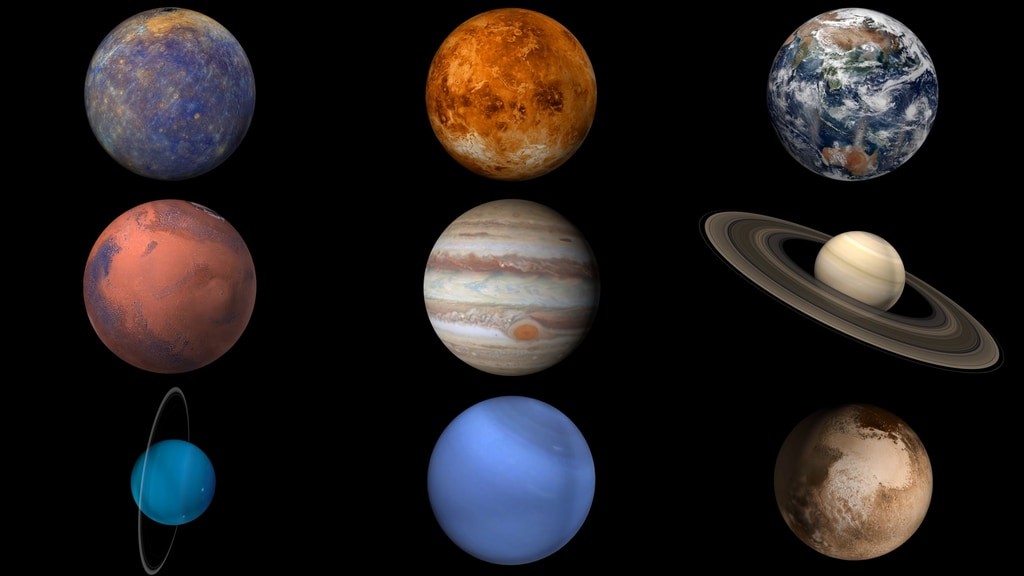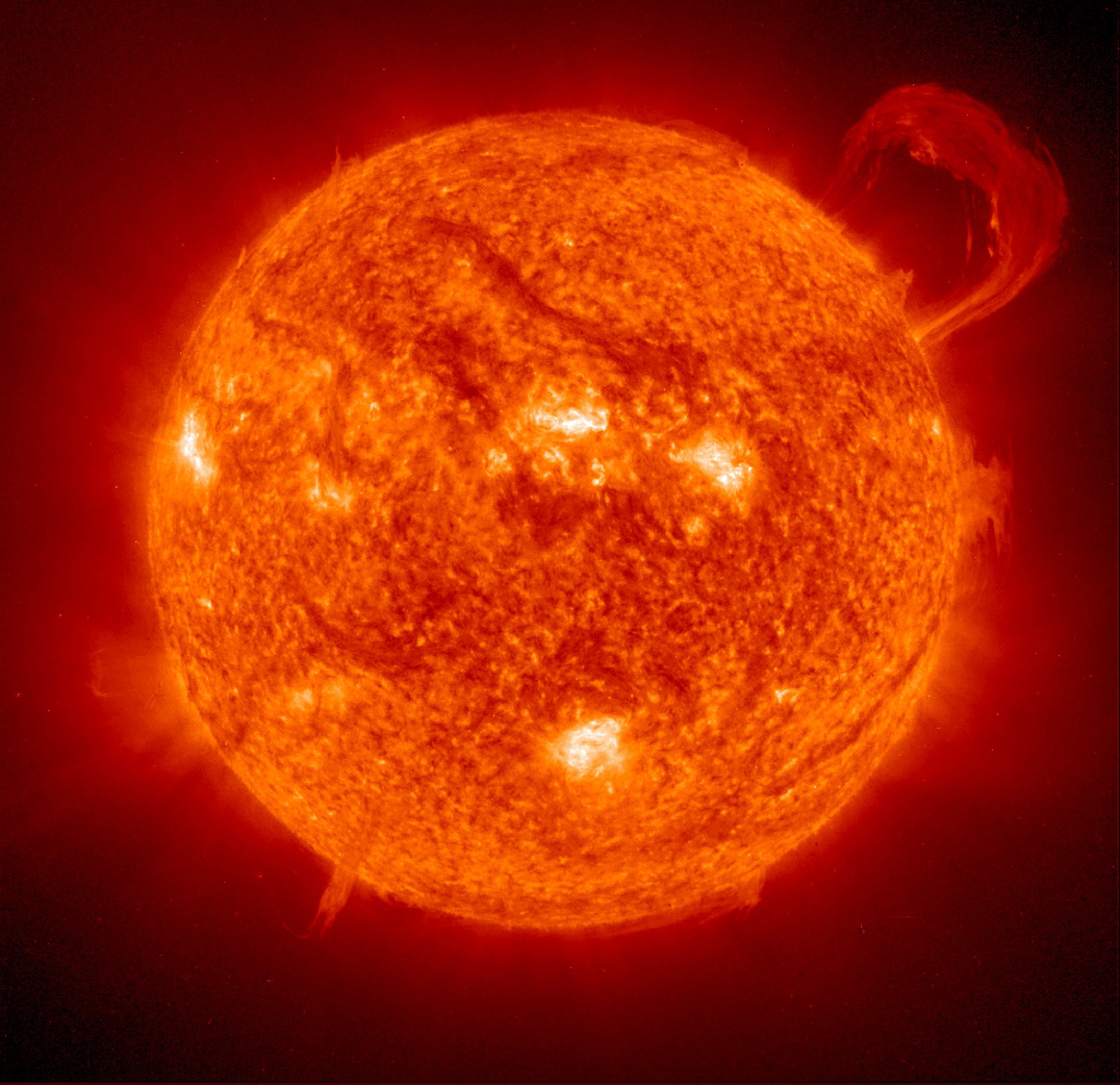How Large Is Jupiter Compared To Other Planets? At COMPARE.EDU.VN, we delve into the colossal scale of Jupiter, the solar system’s giant, and how it dwarfs its planetary siblings, offering a comprehensive understanding of its size. This comparative analysis sheds light on the unique characteristics of Jupiter and its position within our celestial neighborhood, providing valuable insights and facilitating informed perspectives. Explore planetary dimensions and comparative planetology today.
1. Introduction: Jupiter’s Immense Scale
Jupiter, the undisputed heavyweight champion of our solar system, is a gas giant that truly lives up to its name, derived from the king of the Roman gods. Understanding how large Jupiter is compared to other planets requires grasping the sheer magnitude of its size and mass. This article will explore Jupiter’s dimensions in detail, comparing it to Earth and the other planets in our solar system. By the end, you’ll have a clear picture of Jupiter’s dominance and its significant role in the cosmic ballet of our planetary system. This comparison highlights Jupiter’s uniqueness, encouraging you to explore the details on COMPARE.EDU.VN.
2. Jupiter vs. Earth: A David and Goliath Scenario
When contemplating how large is Jupiter compared to other planets, the most striking comparison is with Earth. Earth, our home, seems vast and expansive to us, but when placed next to Jupiter, it’s dwarfed significantly.
2.1 Diameter Comparison
Jupiter’s equatorial diameter is approximately 142,984 kilometers (88,846 miles), while Earth’s is a mere 12,742 kilometers (7,918 miles). This means Jupiter is roughly 11 times wider than Earth. Imagine lining up eleven Earths side by side – that’s approximately the width of Jupiter!
2.2 Volume Comparison
The difference in volume is even more astonishing. It would take about 1,321 Earths to fill up Jupiter. Think of Jupiter as a giant balloon; you could squeeze over a thousand Earths inside!
2.3 Mass Comparison
Jupiter’s mass is about 318 times that of Earth. This immense mass gives Jupiter its gravitational dominance in the solar system, influencing the orbits of asteroids and even affecting the movements of other planets.
Caption: Comparative sizes of the planets in our solar system, showcasing Jupiter’s considerable size compared to Earth and the other planets.
3. How Large is Jupiter Compared to Other Gas Giants?
While Jupiter is the largest planet in the solar system, it’s helpful to see how it stacks up against its fellow gas giants: Saturn, Uranus, and Neptune.
3.1 Jupiter vs. Saturn
Saturn, famous for its stunning ring system, is the second-largest planet. Its equatorial diameter is about 120,536 kilometers (74,898 miles), which is roughly 84% of Jupiter’s diameter. While still massive, Saturn is noticeably smaller than Jupiter.
3.2 Jupiter vs. Uranus
Uranus, an ice giant with a unique sideways rotation, has an equatorial diameter of about 51,118 kilometers (31,763 miles). This makes Uranus about 36% of Jupiter’s size, a significant difference.
3.3 Jupiter vs. Neptune
Neptune, another ice giant, is slightly smaller than Uranus, with an equatorial diameter of about 49,528 kilometers (30,775 miles). Neptune is approximately 35% of Jupiter’s size.
Here’s a table summarizing the comparison:
| Planet | Equatorial Diameter (km) | Diameter Relative to Jupiter |
|---|---|---|
| Jupiter | 142,984 | 100% |
| Saturn | 120,536 | 84% |
| Uranus | 51,118 | 36% |
| Neptune | 49,528 | 35% |


This table clearly illustrates Jupiter’s commanding size advantage over the other gas giants.
4. Jupiter vs. Terrestrial Planets: A Stark Contrast
The terrestrial planets – Mercury, Venus, Earth, and Mars – are rocky and much smaller than the gas giants. Comparing Jupiter to these planets highlights the vast differences in scale within our solar system.
4.1 Jupiter vs. Mercury
Mercury, the smallest planet in our solar system, has an equatorial diameter of only 4,879 kilometers (3,032 miles). Jupiter is almost 30 times wider than Mercury!
4.2 Jupiter vs. Venus
Venus, often called Earth’s “sister planet,” has an equatorial diameter of 12,104 kilometers (7,521 miles). Jupiter is nearly 12 times wider than Venus.
4.3 Jupiter vs. Mars
Mars, the “Red Planet,” has an equatorial diameter of 6,779 kilometers (4,212 miles). Jupiter is more than 21 times wider than Mars.
Here’s a summary table:
| Planet | Equatorial Diameter (km) | Diameter Relative to Jupiter |
|---|---|---|
| Jupiter | 142,984 | 100% |
| Mercury | 4,879 | 3.4% |
| Venus | 12,104 | 8.5% |
| Mars | 6,779 | 4.7% |
The terrestrial planets are mere specks compared to Jupiter.
5. Visualizing Jupiter’s Size: Analogies and Comparisons
Understanding numerical data can be challenging. Here are some analogies to help visualize how large is Jupiter compared to other planets.
5.1 Basketball and Grape Analogy
If Earth were the size of a grape, Jupiter would be about the size of a basketball. This analogy vividly illustrates the size difference.
5.2 Lining Up Planets
You could line up approximately 11 Earths across Jupiter’s diameter. Similarly, you could fit about 2.4 Saturns, 5.6 Uranus, or 5.8 Neptunes across Jupiter.
5.3 Filling Up Jupiter
It would take over 1,300 Earths to fill up Jupiter’s volume. Imagine trying to pack that many Earths into a giant, cosmic balloon!
6. Jupiter’s Great Red Spot: A Storm Bigger Than Earth
One of Jupiter’s most iconic features is the Great Red Spot, a persistent anticyclonic storm located in the planet’s southern hemisphere. This storm is not only visually stunning but also enormous.
6.1 Size of the Great Red Spot
The Great Red Spot is wider than Earth. At its largest, it could accommodate two or even three Earths side by side. While the storm has been shrinking over time, it remains a colossal weather phenomenon.
6.2 Duration of the Great Red Spot
The Great Red Spot has been observed for at least 300 years, and possibly longer. This longevity highlights the dynamic and powerful nature of Jupiter’s atmosphere.
Caption: Jupiter’s Great Red Spot, a storm larger than Earth, illustrating the scale of Jupiter’s atmospheric phenomena.
7. Jupiter’s Mass and Gravitational Influence
Jupiter’s immense mass has significant implications for the entire solar system. Its gravitational pull influences the orbits of asteroids, comets, and even other planets.
7.1 Clearing the Neighborhood
Jupiter’s gravity has cleared many smaller objects from its orbital path, preventing them from potentially colliding with the inner planets. It acts as a cosmic vacuum cleaner, protecting Earth and its neighbors.
7.2 Influencing the Asteroid Belt
The gaps in the asteroid belt, known as Kirkwood gaps, are caused by Jupiter’s gravitational resonances. These resonances disrupt the orbits of asteroids, preventing them from accumulating in certain regions.
7.3 Protecting the Inner Solar System
Jupiter deflects many comets and asteroids away from the inner solar system, reducing the frequency of impact events on Earth. This protective role is crucial for the stability of our planet.
8. Jupiter’s Internal Structure: A Deep Dive
Understanding Jupiter’s internal structure provides insights into its formation, composition, and behavior.
8.1 Composition
Jupiter is primarily composed of hydrogen and helium, similar to the Sun. However, deeper inside, the pressure and temperature increase dramatically.
8.2 Liquid Metallic Hydrogen
At great depths, the hydrogen gas is compressed into a liquid metallic form. This liquid metallic hydrogen is an excellent conductor of electricity and is responsible for Jupiter’s powerful magnetic field.
8.3 Core
Jupiter is believed to have a dense core of rock, metal, and ice. However, the exact size and composition of the core are still subjects of scientific debate. Data from NASA’s Juno mission suggests that Jupiter’s core may be larger and more diffuse than previously thought.
9. Jupiter’s Magnetic Field: A Planetary Shield
Jupiter has the strongest magnetic field of any planet in the solar system. This magnetic field extends millions of kilometers into space, forming a vast magnetosphere.
9.1 Strength of the Magnetic Field
Jupiter’s magnetic field is about 20,000 times stronger than Earth’s. This powerful field traps charged particles from the solar wind, creating intense radiation belts around the planet.
9.2 Aurorae
Jupiter’s magnetic field also causes spectacular aurorae at the planet’s poles. These aurorae are much more energetic than those on Earth and can be observed in ultraviolet light.
9.3 Influence on Moons
Jupiter’s magnetic field interacts with its moons, particularly Io, which is volcanically active. The interaction between Io and Jupiter’s magnetic field generates powerful electric currents that flow between the planet and the moon.
10. Jupiter’s Moons: A Mini Solar System
Jupiter has 95 officially recognized moons, forming a complex and fascinating system. The four largest moons, known as the Galilean moons, are particularly noteworthy.
10.1 Galilean Moons
The Galilean moons – Io, Europa, Ganymede, and Callisto – were discovered by Galileo Galilei in 1610. Each moon has unique characteristics and geological features.
10.2 Io
Io is the most volcanically active body in the solar system. Its surface is covered with volcanoes, lava flows, and sulfur deposits.
10.3 Europa
Europa is believed to have a subsurface ocean of liquid water, making it a prime target in the search for extraterrestrial life.
10.4 Ganymede
Ganymede is the largest moon in the solar system, even larger than the planet Mercury. It has its own magnetic field and a complex surface with both ancient and young terrains.
10.5 Callisto
Callisto is the most heavily cratered moon in the solar system. Its ancient surface provides a record of billions of years of impact events.
Caption: An artistic rendering of Jupiter and its moons, illustrating the diverse and fascinating system of satellites around the gas giant.
11. Jupiter’s Rings: A Faint Halo
Jupiter has a faint ring system, composed of dust particles. These rings are not as prominent as Saturn’s, but they are still an interesting feature.
11.1 Composition of the Rings
Jupiter’s rings are made up of small, dark particles, likely originating from impacts on the planet’s small inner moons.
11.2 Structure of the Rings
The ring system consists of several distinct components, including a main ring, a halo, and two gossamer rings.
11.3 Visibility of the Rings
Jupiter’s rings are difficult to see except when backlit by the Sun. They were first discovered by NASA’s Voyager 1 spacecraft in 1979.
12. The Juno Mission: Unveiling Jupiter’s Secrets
NASA’s Juno mission has been providing valuable insights into Jupiter’s interior, atmosphere, and magnetic field.
12.1 Mission Objectives
The Juno spacecraft was launched in 2011 and arrived at Jupiter in 2016. Its primary objectives are to study Jupiter’s composition, gravity field, magnetic field, and polar magnetosphere.
12.2 Key Discoveries
Juno has made several important discoveries, including the detection of a large and diffuse core, the mapping of Jupiter’s magnetic field with unprecedented accuracy, and the observation of complex atmospheric dynamics.
12.3 Future of the Mission
The Juno mission has been extended and will continue to study Jupiter for several more years, providing even more data about this fascinating planet.
13. Comparative Planetology: Placing Jupiter in Context
Understanding how large is Jupiter compared to other planets is essential for comparative planetology, the study of the similarities and differences between planets.
13.1 Gas Giants vs. Terrestrial Planets
The contrast between gas giants like Jupiter and terrestrial planets like Earth highlights the diverse range of planetary types in our solar system.
13.2 Exoplanets
Studying Jupiter can also help us understand exoplanets, planets orbiting other stars. Many exoplanets are gas giants similar in size and composition to Jupiter.
13.3 Formation of Planetary Systems
The size and location of Jupiter have significant implications for the formation and evolution of our solar system and other planetary systems.
14. Implications for Life: Is Jupiter Habitable?
While Jupiter itself is not considered habitable due to its extreme conditions, its moons, particularly Europa, are of interest in the search for extraterrestrial life.
14.1 Europa’s Subsurface Ocean
Europa’s subsurface ocean may provide a habitable environment for microbial life. The presence of liquid water, energy sources, and chemical building blocks makes Europa a promising target for future exploration.
14.2 Future Missions
NASA’s Europa Clipper mission, scheduled to launch in 2024, will study Europa’s ocean, ice shell, and geology, assessing its potential habitability.
14.3 The Search for Extraterrestrial Life
The search for life beyond Earth is one of the most exciting and challenging endeavors in science. Jupiter and its moons play a significant role in this quest.
15. Jupiter in Culture and Mythology
Jupiter, named after the king of the Roman gods, has been a source of fascination and inspiration throughout human history.
15.1 Roman Mythology
In Roman mythology, Jupiter was the supreme deity, associated with the sky, thunder, and justice. The planet’s name reflects its dominant size and importance.
15.2 Astronomy and Astrology
Jupiter has been observed and studied by astronomers for centuries. In astrology, Jupiter is associated with good fortune, abundance, and expansion.
15.3 Science Fiction
Jupiter and its moons have been featured in numerous works of science fiction, inspiring imaginations and fueling speculation about the possibility of life beyond Earth.
16. Why Does Jupiter’s Size Matter?
Understanding how large is Jupiter compared to other planets isn’t just a matter of curiosity; it’s crucial for comprehending the dynamics and evolution of our solar system.
16.1 Gravitational Influence
Jupiter’s size dictates its gravitational influence, shaping the orbits of other celestial bodies and protecting the inner planets from impacts.
16.2 Atmospheric Dynamics
The size and composition of Jupiter’s atmosphere lead to extreme weather phenomena, such as the Great Red Spot.
16.3 Planetary Formation
Jupiter’s formation and evolution provide insights into the processes that govern the formation of planetary systems.
17. Future Research and Exploration of Jupiter
The exploration of Jupiter is an ongoing endeavor, with future missions planned to further unravel the mysteries of this giant planet.
17.1 Continued Data Analysis
Scientists will continue to analyze data from the Juno mission for years to come, refining our understanding of Jupiter’s interior, atmosphere, and magnetic field.
17.2 New Technologies
Advances in technology will enable new and innovative approaches to studying Jupiter, such as advanced telescopes, probes, and rovers.
17.3 International Collaboration
The exploration of Jupiter is a global effort, involving scientists and engineers from around the world.
18. Understanding Planetary Sizes: A Broader Perspective
Knowing how large is Jupiter compared to other planets encourages a broader understanding of planetary sizes and their implications.
18.1 Planetary Science Education
Comparative planetology enhances planetary science education, helping students and enthusiasts grasp the scale and diversity of our solar system.
18.2 Space Exploration Advocacy
Understanding the size and significance of Jupiter can inspire greater public support for space exploration and scientific research.
18.3 Cosmic Perspective
Contemplating the size of Jupiter and its place in the cosmos fosters a sense of perspective and wonder, reminding us of the vastness and complexity of the universe.
19. Key Takeaways: Jupiter’s Size in Perspective
To summarize, Jupiter is the largest planet in our solar system, dwarfing Earth and its other planetary neighbors. Its immense size has profound implications for the dynamics, composition, and evolution of our solar system.
19.1 Relative Size
Jupiter is approximately 11 times wider than Earth and contains more than twice the mass of all the other planets combined.
19.2 Influence
Its gravitational influence shapes the orbits of asteroids, protects the inner planets from impacts, and generates powerful magnetic fields and aurorae.
19.3 Importance
Studying Jupiter provides insights into the formation of planetary systems, the search for extraterrestrial life, and the broader context of our place in the cosmos.
20. Explore More at COMPARE.EDU.VN
For more detailed comparisons and information about Jupiter and the other planets in our solar system, visit COMPARE.EDU.VN. Our website offers comprehensive resources, data visualizations, and expert analysis to help you understand the wonders of the universe. We provide detailed comparisons, facilitating informed decisions. Discover more today.
Ready to make informed decisions? Explore detailed comparisons and analysis on COMPARE.EDU.VN today!
For further inquiries, contact us at:
Address: 333 Comparison Plaza, Choice City, CA 90210, United States
WhatsApp: +1 (626) 555-9090
Website: compare.edu.vn
FAQ About Jupiter’s Size
1. How much bigger is Jupiter than Earth?
Jupiter is about 11 times wider than Earth and has about 318 times the mass.
2. Could Earth fit inside Jupiter?
Yes, you could fit about 1,321 Earths inside Jupiter.
3. Is Jupiter bigger than all the other planets combined?
Almost. Jupiter contains more than twice the mass of all the other planets in the solar system combined.
4. How does Jupiter’s size affect its gravity?
Jupiter’s large size gives it a strong gravitational pull, which influences the orbits of asteroids and protects the inner planets from impacts.
5. What is the Great Red Spot, and how big is it?
The Great Red Spot is a giant storm on Jupiter that is wider than Earth.
6. Why is Jupiter so large compared to the other planets?
Jupiter formed early in the solar system’s history and captured a large amount of gas and dust, allowing it to grow to its immense size.
7. How does Jupiter’s size compare to Saturn?
Jupiter is larger than Saturn. Saturn is about 84% of Jupiter’s diameter.
8. Does Jupiter have a solid surface?
No, Jupiter is a gas giant and does not have a solid surface. It is primarily composed of hydrogen and helium.
9. How does Jupiter’s size affect its moons?
Jupiter’s gravity influences the orbits and geological activity of its moons, particularly the Galilean moons.
10. What is the Juno mission, and what has it taught us about Jupiter’s size?
The Juno mission is a NASA mission that has provided valuable data about Jupiter’s interior, atmosphere, and magnetic field, helping us understand the planet’s size, composition, and dynamics.
